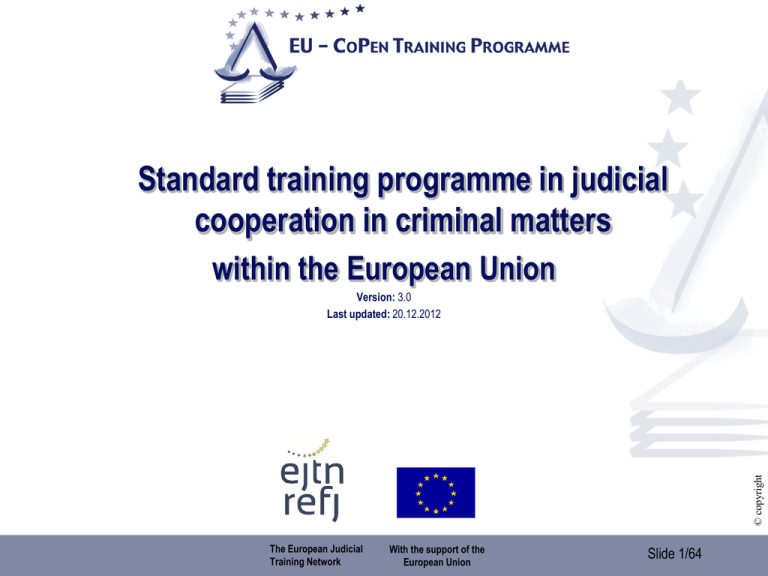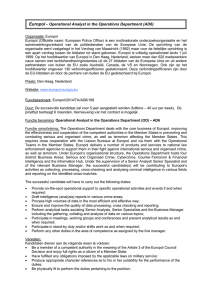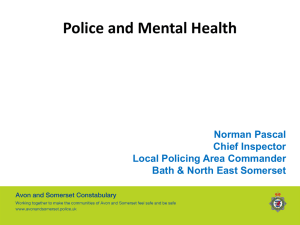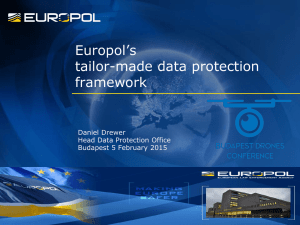Police cooperation
advertisement

Standard training programme in judicial cooperation in criminal matters within the European Union © copyright Version: 3.0 Last updated: 20.12.2012 The European Judicial Training Network With the support of the European Union Slide 1/64 logo of the training organiser Training organised by (name of training organiser) on (date) at (place) © copyright Title (of the training/ module) The European Judicial Training Network With the support of the European Union Slide 2/64 © copyright Module 5 Police cooperation Version: 3.0 Last updated: 20.12.2012 Slide 3/64 Contents 1. Introduction (history) 2. Exchanging information 1. Europol 2. The SIS 3. Interpol 4. Liaison officers 5. Financial Intelligence Units 6. Cooperation in border areas 7. Police Chiefs Task Force > Module 5: police cooperation © copyright 3. The stakeholders Slide 4/64 1. Introduction 1. Police cooperation before 1990: • Somewhat informal • Bilateral cooperation, Interpol, Trevi etc. 2. Schengen (Convention of 1990) • Information exchange, SIS, cross-border surveillance and hot pursuit • Gradual expansion to almost all Member States 4. The Hague Programme (2004): exchange of information and internal security strategy 5. Lisbon Treaty: institutional changes in particular > Module 5: police cooperation Slide 5/64 © copyright 3. Europol (1995) 2. Exchanging information Comments: • Initial work: to facilitate the secure transmission of information • Europol: sharing and analysis of information • ‘Principle of availability’ © copyright Source of problems often = internal coordination issues > Module 5: police cooperation Slide 6/64 2. Exchanging information • Article 39 of the Schengen Convention has long been the only general legal basis (= hereinafter Art. 39) • Replaced by the Framework Decision of 18 December 2006 on simplifying the exchange of information start of implementation of the principle of availability (= hereafter the FD) • (Note: the Prüm Treaty (partially integrated into EU law by Decision 2008/615/JHA) goes beyond the Framework Decision of 18 Dec 2006 by establishing direct access but limited to three types of information – see below) > Module 5: police cooperation Slide 7/64 © copyright 2.1. Legal procedure for the exchange of information 2. Exchanging information (2.1. Legal procedure for exchange of information) 2.1.1. Scope: General (all offences) 2.1.2. Information concerned • Art. 39: not specified • 2006 FD: determining criterion = availability of the information. Included: - Anything that has already been collected (possibility of excluding anything obtained through coercive measures) © copyright - Which already exists and to which the police have access without coercive measures (whether or not judicial authorisation is required) > Module 5: police cooperation Slide 8/64 2. Exchanging information (2.1. Legal procedure for exchange of information) 2.1.3. Exclusion from use as evidence Information collected at a preliminary stage of the investigation If the information is to be used as evidence, obligation to use judicial cooperation channels: To obtain the info (it has not yet been transmitted) • To ‘validate’ the info (if it has already been transmitted) © copyright • > Module 5: police cooperation Slide 9/64 2. Exchanging information (2.1. Legal procedure for exchange of information) 2.1.4. Involvement of the judicial authority • Art. 39: where the law makes access subject to the authorisation of the judicial authority use judicial cooperation channels FD of 2006: - Judicial authorisation may still be required if necessary for access to the information at national level - The fact that judicial authorisation is required may not be in itself an obstacle to exchange via police channels © copyright • > Module 5: police cooperation Slide 10/64 2. Exchanging information (2.1. Legal procedure for exchange of information) 2.1.5. Grounds for refusal (FD of 2006) the information is already in the possession of the police services but was obtained by means of coercive measures (choice left to the Member States) • conventional grounds for refusal: national interests, protecting the ongoing investigation or the safety of an individual. • possible to refuse to execute requests that appear to be manifestly disproportionate • requests relating to minor offences may be refused. © copyright • > Module 5: police cooperation Slide 11/64 2. Exchanging information (2.1. Legal procedure for exchange of information) new legal procedure not revolutionary but clarifies the separation between police cooperation and judicial cooperation. The decisive factor is no longer the fact that the information is subject to judicial supervision, but the fact that the request does not concern obtaining evidence. © copyright Application of Framework Decision 2006/960/JHA evaluated in late 2011. Relatively low level of implementation. > Module 5: police cooperation Slide 12/64 2. Exchanging information 2.2. Direct access to police databases Prüm Treaty (2005) integrated, at least the part relating to direct access to databases, into the EU law by Decision 2008/615/JHA of 23 June 2008 Direct access to databases: • Vehicle registrations • Fingerprints (hit / no hit) • DNA (hit / no hit) - Access via a central contact point in each Member State - Access limited to a case-by-case search > Module 5: police cooperation © copyright General comments Slide 13/64 2. Exchanging information (2.2. Direct access to police databases) Direct access to vehicle registration records The access to vehicle registration records is the most extensive under the Prüm system. This is truly direct access to the data, including personal data. This access is via the EUCARIS system. © copyright As at 1 November 2012, the following countries were ‘interconnected’: DE, AT, ES, BE, FR, LU, NL, RO, SI, FI. > Module 5: police cooperation Slide 14/64 2. Exchanging information (2.2. Direct access to police databases) Direct access to fingerprints records Hit / no hit access: only tells you whether a fingerprint is known - Via mutual legal assistance if the information is requested for the purposes of obtaining evidence - Possibility of obtaining info via police cooperation in other cases (with 8-hour time limit for urgent cases, cf FD 2009/960/JHA) and then ‘validating’ information that proves necessary for evidential purposes As at 12 October 2012, the following countries are connected to certain others but not all are necessarily interconnected (see the table for further details): BG, CZ, DE, ES, FR, LT, LU, NL, AT, SI, SK. See appendix for detailed info. > Module 5: police cooperation Slide 15/64 © copyright If a fingerprint is known, how can more information be obtained? 2. Exchanging information (2.2. Direct access to police databases) Direct access to DNA records Hit / no hit access: only tells you whether a fingerprint is known If a fingerprint is known, how can more information be obtained? In theory, possibility of using police cooperation channels if not at the stage of obtaining evidence but mutual legal assistance probably required by most States. © copyright As at 12 October 2012, the following countries are connected to certain others but not all are necessarily interconnected (see the table for further details): BG, DE, ES, FR, LV, LU, NL, AT, RO, SI, SK, FI. See appendix for detailed info. > Module 5: police cooperation Slide 16/64 3. Stakeholders and channels 1. Europol 2. The SIS 3. Interpol 4. Liaison officers 5. Financial intelligence units 6. Cooperation in border areas © copyright 7. Police chiefs Task Force > Module 5: police cooperation Slide 17/64 3.1. EUROPOL 3.1.1. Fact sheet • Europol Convention of 26 July 1995, amended several times and replaced by ‘Europol Decision’ 2009/371/JHA of 6 April 2009 • Became operational on 1 July 1999 • Headquarters: The Hague © copyright • Composition: about 500 officers + liaison officers > Module 5: police cooperation > 3. Stakeholders and channels Slide 18/64 3.1. EUROPOL 3.1.2. Introduction Main function: making structured information relating to criminal investigations available to national authorities and carrying out strategic and operational analysis of this information. Relationship with the work of the investigating judge – Europol assistance can occur: © copyright • in advance of the work of the investigating judge (the information provided by or via Europol may contribute to an investigation being opened) • during the investigation itself (Europol’s assistance may make it possible, for example, to highlight links with ongoing investigations in other Member States). > Module 5: police cooperation > 3. Stakeholders and channels Slide 19/64 3.1. EUROPOL 3.1.3. Objectives => Improve the effectiveness of police cooperation by providing assistance to national police authorities. © copyright Europol is not a European ‘FBI’ => no investigative power of its own and supervision over investigations retained at Member State level > Module 5: police cooperation > 3. Stakeholders and channels Slide 20/64 3.1. EUROPOL 3.1.4. Competences 3.1.4.1. Material field of action: Exhaustive list but broad types of crime 3.1.4.2. ‘Temporal’ fields of action: prevention and suppression © copyright 3.1.4.3. ‘Territorial’ field of action: must generally involve at least two Member States > Module 5: police cooperation > 3. Stakeholders and channels Slide 21/64 3.1. EUROPOL 3.1.5. Structure a) Management board b) Director c) Staff d) Europol National Units (UNE) = interface between the national level and Europol • Often grouped with Interpol national bureau, SIRENE bureau etc. • Mandatory channel for transmitting information to Europol © copyright • > Module 5: police cooperation > 3. Stakeholders and channels Slide 22/64 3.1. EUROPOL © copyright 3.1.5. Structure > Module 5: police cooperation > 3. Stakeholders and channels Slide 23/64 3.1. EUROPOL 3.1.5. Structure National situation © copyright Indicate here the contact details of the ENU in your country > Module 5: police cooperation > 3. Stakeholders and channels Slide 24/64 3.1. EUROPOL 3.1.5. Structure e) Liaison Officers and National Liaison Bureaux • Each Member State seconds at least one liaison officer to Europol. • On average, four liaison officers from each Member State. • = extension of the ENU: contact between the ENU and Europol goes through them. • Cooperation not only within Europol but also between liaison officers (bilateral coop) Indicate here the contact details of the Europol liaison officers in your country > Module 5: police cooperation > 3. Stakeholders and channels Slide 25/64 © copyright National situation 3.1. EUROPOL 3.1.6. Europol’s reach 3.1.6.1. Exchange, sharing and analysis of information Main added value of Europol = ability to process and analyse information • 3.1.6.1.1. Exchanging info © copyright Not strictly Europol, but rather the channel of the liaison officers at Europol > Module 5: police cooperation > 3. Stakeholders and channels Slide 26/64 3.1. EUROPOL • 3.1.6.1.2. Providing information: the Europol information system (EIS) - Operational since 2005 - Contains data on perpetrators and suspects © copyright - Accessible online to the ENUs and liaison officers > Module 5: police cooperation > 3. Stakeholders and channels Slide 27/64 3.1. EUROPOL • 3.1.6.1.2. Providing information: the Europol information system (EIS) Practical example Conducting an investigation into drugs trafficking, the Austrian police suspect X of playing a coordinating role in the criminal organisation. By entering X’s personal data into the EIS, the Austrian ENU discovers that X is also a suspect in a similar investigation conducted by the Italian police. Following this information, the Austrian liaison officer will contact his Italian colleague in The Hague to initiate cooperation. For example, in late 2011, the EIS contained data on 183 240 objects and 41 193 individuals, and 111 110 searches were run through the system in the past year. The crime areas concerned were drug trafficking (25% of all objects), trafficking in human beings (23%), forgery of money (18%), robbery (10%) and fraud (5%) . > Module 5: police cooperation > 3. Stakeholders and channels Slide 28/64 © copyright [Ex_mod5_V10_europol_1.1] 3.1. EUROPOL • 3.1.6.1.3. Information analysis: analysis work files = Temporary files created for a specific crime issue Practical example (part I) Italy requests the creation of an analysis work file on the trafficking of human beings from Central Asia. © copyright [Ex_mod5_V10_europol_2.1] > Module 5: police cooperation > 3. Stakeholders and channels Slide 29/64 3.1. EUROPOL • 3.1.6.1.3. Information analysis: analysis work files Each Member State may choose whether to participate In 2005, 18 analysis work files were created at Europol Practical example (part II) France and Belgium decide to participate in the analysis work file, since, based on information provided by Italy, the French and Belgian police believe it is likely that one or more joint criminal networks are involved. The analysis group therefore comprises Italian, French and Belgian and Europol analysts. © copyright [Ex_mod5_V10_europol_2.2] > Module 5: police cooperation > 3. Stakeholders and channels Slide 30/64 3.1. EUROPOL • 3.1.6.1.3. Information analysis: analysis work files Participants add info to the analysis file The file contains detailed data about individuals (broader than suspects and perpetrators) Practical example (part III) As part of a case falling within the field of action of analysis work file F, the Belgian police monitor X, who is suspected of acting as a contact with prostitution networks, for several months. They encode data in the analysis work file regarding X, such as surname; first name; address; vehicle; places frequented; lifestyle; personality traits; identifying physical characteristics etc. © copyright [Ex_mod5_V10_europol_2.3] > Module 5: police cooperation > 3. Stakeholders and channels Slide 31/64 3.1. EUROPOL • 3.1.6.1.3. Information analysis: analysis work files Practical example (part IV) The Italian police seize a mobile telephone during a search. The telephone is fitted with an anonymous prepaid card but, following contact with the telephone operator concerned, the Belgian police are able to draw up a list of the telephone numbers with which communications have taken place during the previous months. All these telephone numbers and their subscribers, if known, will be encoded in the analysis work file. © copyright [Ex_mod5_V10_europol_2.4] > Module 5: police cooperation > 3. Stakeholders and channels Slide 32/64 3.1. EUROPOL • 3.1.6.1.3. Information analysis: analysis work files Expected results: bringing to light hidden characteristics that can be used by investigators, such: revealing a modus operandi - identifying the routes used by the criminal organisation - the role played by certain individuals in the network - … © copyright - > Module 5: police cooperation > 3. Stakeholders and channels Slide 33/64 3.1. EUROPOL • 3.1.6.1.3. Information analysis: analysis work files Role of the judicial authorities in the analysis work files varies from one State to the next © copyright in some States, the decision to start adding info to the file falls to the judicial authority > Module 5: police cooperation > 3. Stakeholders and channels Slide 34/64 3.1. EUROPOL 3.1.6.1.4. SIENA platform • Latest of Europol’s key tools. • Enables interconnection between Europol databases, information exchanged bilaterally by liaison officers at Europol, and national databases. • Will automate the transmission of information to Europol. • Eventually, it will also act as a platform for the exchange of information between databases in the Member States. • 330,000 messages exchanged in 2011 via SIENA > Module 5: police cooperation > 3. Stakeholders and channels © copyright • Slide 35/64 3.1. EUROPOL • 3.1.6.1.5. Europol strategic analysis Includes the annual report on the organised crime threat analysis taken into account by the Council to identify annual priorities © copyright source of European criminal policy and the security plan > Module 5: police cooperation > 3. Stakeholders and channels Slide 36/64 3.1. EUROPOL 3.1.6.2. Europol’s involvement in managing investigations Protocol of 30 November 2002: - Europol may request (non-binding) that national authorities initiate investigations - Europol may participate in joint investigation teams (see Module 4) 3.1.6.3. Material, logistical and expert support © copyright Various resources, expertise e.g. in euro counterfeiting. Hosts the European Cybercrime Centre > Module 5: police cooperation > 3. Stakeholders and channels Slide 37/64 3.1. EUROPOL 3.1.7. Cooperation beyond the EU Europol partnerships with third States and international organisations Require formal agreements © copyright These agreements may include the exchange of personal data > Module 5: police cooperation > 3. Stakeholders and channels Slide 38/64 3.1. EUROPOL 3.1.8. Conclusion => at European level, judicial officers involved in judicial cooperation will generally liaise with Eurojust and/or the European Judicial Network But contact with Europol may occur at various stages: the decision to open the investigation may be based on information transmitted by Europol (analysis work file); 2. investigators may approach Europol liaison officers as a channel for requesting certain information from other Member States; 3. searches of the EIS by investigators may lead to new developments in the investigation, for example by revealing links with other cases; 4. an investigation may be facilitated by insights gained from a Europol analysis work file; 5. if a matter is referred to Eurojust, it may consult Europol and request its assistance; 6. setting up a joint investigation team should lead to Europol employees being asked to participate in that team. > Module 5: police cooperation > 3. Stakeholders and channels © copyright 1. Slide 39/64 3.2. The SIS 3.2.1. Introduction The Schengen Information System (SIS) = to issue an alert for persons and objects for measures to be taken if the person or object is found in one of the Schengen States • Created by the 2000 Conv. • Work underway to replace the SIS with the SIS II, more effective, but significant difficulties in this project. The SIS II should be operational in 2013. © copyright • > Module 5: police cooperation > 3. Stakeholders and channels Slide 40/64 3.2. The SIS 3.2.2. Territorial scope • ‘Old’ EU member countries of the Schengen area: Germany, Austria, Belgium, Denmark, Spain, France, Greece, Italy, Luxembourg, Netherlands, Portugal, Sweden, Finland. • ‘Recent’ EU countries that joined the Schengen area on 21 December 2007: Estonia, Latvia, Lithuania, Poland, Slovakia, Czech Rep., Hungary, Slovenia, Malta • Non-EU member countries of the Schengen area: Iceland, Norway + (December 2008) Switzerland > Module 5: police cooperation > 3. Stakeholders and channels Slide 41/64 © copyright As at 1 September 2009: 3.2. The SIS 3.2.2. Territorial scope The following countries should have access in the next few years: • EU countries that are future members of the Schengen area: Cyprus, Bulgaria and Romania • EU countries not members of the Schengen area: United Kingdom © copyright => Ireland has indicated its commitment to joining the SIS, but this process appears to have stalled. > Module 5: police cooperation > 3. Stakeholders and channels Slide 42/64 3.2. The SIS 3.2.3. Structure • A central system located in Strasbourg (C-SIS). • National systems (N-SIS), ‘mirrors’ of the C-SIS • One authority per Member State responsible for inputting the data National situation • One SIRENE bureau per State responsible for supplementary exchanges of information > Module 5: police cooperation > 3. Stakeholders and channels Slide 43/64 © copyright Indicate here the SIS central authority for your country 3.2. The SIS 3.2.4. How it works • Several types of alert, defined by the object (that which is inputted) and the purpose (measure to be taken if the object is found) • Main alerts: - Persons wanted for extradition purposes or on the basis of an EAW (see Module 8) -Alerts for objects with a view to seizure © copyright - Alerts for persons or vehicles with a view to discreet surveillance > Module 5: police cooperation > 3. Stakeholders and channels Slide 44/64 3.2. The SIS 3.2.4. How it works Issue of an alert: by the SIS national central authority but on any request from a competent authority • Executing the alert: in the event of a hit, the authority that finds the person or object must take the requested measure attached to the alert (e.g. seizure of the object). © copyright • > Module 5: police cooperation > 3. Stakeholders and channels Slide 45/64 3.2. The SIS 3.2.4. How it works Access to the SIS: • in principle, the SIS is not an investigative tool, only a checking tool • However: accessed by Europol, Eurojust and potentially by the State security agencies (SIS II) National situation Indicate here the authorities with access to the SIS in your country > Module 5: police cooperation > 3. Stakeholders and channels © copyright Indicate here the contact details of your SIRENE bureau Slide 46/64 3.2. The SIS Practical example 1. Alert request by a competent authority of State A (E.g.: As part of a drug trafficking case, police in Marseilles (France) want to trace a vehicle with registration number XYZ. They request an alert for the vehicle in order for it to be searched. 3. If appropriate, transmission of supplementary information via the SIRENE Bureaux E.g. By way of supplementary information, the French SIRENE Bureau transmits the fact that the search is based on the suspected presence of heroin in the vehicle. © copyright 2. Verification and encoding by the SIRENE Bureau of State A [ex_mod5_V10_SIS_1.1] > Module 5: police cooperation > 3. Stakeholders and channels Slide 47/64 3.2. The SIS Practical example (part II) 4. Automatic updating of the C-SIS 5. Transmission of the alert to the N-SIS of the other Member States and validation of the alert by the SIRENE Bureaux of the other Member States => The alert is now operational throughout the Schengen Area. © copyright [ex_mod5_V10_SIS_1.2] > Module 5: police cooperation > 3. Stakeholders and channels Slide 48/64 3.2. The SIS Practical example (part III) 6. ‘Hit’ in Member State B and execution of the requested action E.g.: During a routine road traffic check, Barcelona police stop vehicle XYZ. The officer in question transmits the vehicle’s details to his information centre; having checked the national data base, the information centre informs the officer that the vehicle is the subject of an alert and that a search is required. The officer carries out the search but does not find any trace of drugs in the vehicle. © copyright [ex_mod5_V10_SIS_1.3] > Module 5: police cooperation > 3. Stakeholders and channels Slide 49/64 3.2. The SIS Practical example (part IV) 7. Transmission of information about the ‘hit’ from the SIRENE Bureau of State B to the SIRENE Bureau of State A. E.g.: The Spanish SIRENE Bureau transmits the following information to the French SIRENE Bureau: place and time of the check, persons present in the vehicle, result of the search. © copyright [ex_mod5_V10_SIS_1.4] > Module 5: police cooperation > 3. Stakeholders and channels Slide 50/64 3.3. Interpol Located in Lyon (France), purely intergovernmental (no founding convention) 3.3.1. Structure and functioning - A General Assembly and a General Secretariat (450-500 employees) - In each Member State, a National Central Bureau (NCB) National situation © copyright Indicate here the contact details of the Interpol NCB for your country > Module 5: police cooperation > 3. Stakeholders and channels Slide 51/64 3.3. Interpol (3.3.3. Operational action) • the I-24/7 network: technical link between the NCBs and Interpol • Interpol alerts: - Red notice: arrest and extradition - Blue notice: additional information on suspects - Yellow notice: missing person - Black notice: unidentified corpse © copyright -…. > Module 5: police cooperation > 3. Stakeholders and channels Slide 52/64 3.3. Interpol (3.3.3. Operational action) Each alert must be validated by the General Secretariat (72 hr time limit) Interpol = alerts only © copyright No obligation to arrest the person in the event of a red notice, depends on the instruments binding the two countries > Module 5: police cooperation > 3. Stakeholders and channels Slide 53/64 3.3. Interpol (3.3.3. Operational action) Interpol Alert / SIS Alert •Interpol is still used because: - SIS not yet accessible throughout EU territory - always a risk that the person has left EU territory © copyright => Interpol red notice not equivalent to an EAW (><SIS) > Module 5: police cooperation > 3. Stakeholders and channels Slide 54/64 3.4. Liaison officers • Initially a bilateral initiative • Importance of a person permanently located in the other State, direct contact, interpersonal links etc. • Non-binding framework set at EU level (Council Decision of 27 February 03) • Importance of regular meetings of EU liaison officers in third countries (e.g. Russia) © copyright • Ensure that each EU country benefits from the assistance of the liaison officers of other Member States > Module 5: police cooperation > 3. Stakeholders and channels Slide 55/64 3.5. Financial intelligence units •Set up in each Member State in the context of combating money laundering. •Requirement for certain professions to transmit intelligence relating to suspicious transactions (money laundering or financing terrorism) to the national FIUs. The primary task of the FIUs is to process this intelligence. © copyright •Council Decision 2000/424/JHA of 17 October 2000: organising information exchange between the FIUs of the different Member States, which therefore represent a preferential channel for exchanging information in the areas of money laundering and financing terrorism. > Module 5: police cooperation > 3. Stakeholders and channels Slide 56/64 3.5. Financial intelligence units National situation © copyright Indicate here the contact details of the FIU for your country > Module 5: police cooperation > 3. Stakeholders and channels Slide 57/64 3.6. Cooperation in border areas • The minimum = Schengen Conv. (cross-border surveillance and hot pursuit) for the Schengen States • But some States go further vis-à-vis some of their neighbouring countries • E.g. the ‘joint police stations’ bringing together officers from two States in single location near the border © copyright • Joint patrols etc. > Module 5: police cooperation > 3. Stakeholders and channels Slide 58/64 3.6. Cooperation in border areas National situation © copyright Enter here useful information regarding specific cooperation in the border areas of your State. > Module 5: police cooperation > 3. Stakeholders and channels Slide 59/64 3.7. Towards an effective and coherent EU strategy The EU is developing a ‘policy cycle on organised and serious crime’ intelligence-led policing method. 4-year cycle: - Based on the SOCTA (Serious and Organised Crime Threat Assessment) produced by Europol = threat analysis - SOCTA sent to the COSI (Standing Committee on Internal Security, reporting to the EU Council) and to the Council to identify priorities - Priorities implemented by EU and national stakeholders - Interim assessment > Module 5: police cooperation > 3. Stakeholders and channels © copyright - New SOCTA and new cycle after 4 years Slide 60/64 3.7. Towards an effective and coherent EU strategy Priorities identified in 2011: Weaken the capacity of organised crime groups active or based in West Africa to traffic cocaine and heroin to and within the EU - Mitigate the role of the Western Balkans, as a key transit and storage zone for illicit commodities destined for the EU and logistical centre for organised crime groups, including Albanian-speaking organised crime groups; - Weaken the capacity of organised crime groups to facilitate illegal immigration to the EU, particularly via southern, south-eastern and eastern Europe and notably at the GreekTurkish border and in crisis areas of the Mediterranean close to North Africa; © copyright - > Module 5: police cooperation > 3. Stakeholders and channels Slide 61/64 3.7. Towards an effective and coherent EU strategy Priorities identified in 2011: © copyright • Reduce the production and distribution in the EU of synthetic drugs, including new psychoactive substances; • Disrupt the trafficking to the EU, particularly in container form, of illicit commodities, including cocaine, heroin, cannabis, counterfeit goods and cigarettes; • Combat against all forms of trafficking in human beings and human smuggling by targeting the organised crime groups conducting such criminal activities in particular at the southern, south-western and south-eastern criminal hubs in the EU; • Reduce the general capabilities of mobile (itinerant) organised crime groups to engage in criminal activities; • Step up the fight against cybercrime and the criminal misuse of the internet by organised crime groups. > Module 5: police cooperation > 3. Stakeholders and channels Slide 62/64 3.7. Towards an effective and coherent EU strategy Involvement of the judicial authorities in this cycle may take place at three levels: Participation of national judicial authorities in the COSI; • Implementation of the priorities identified by the Council; • Eurojust participates in the policy cycle, both before and after; • The Consultative Forum of Prosecutors General aims to ensure national public prosecutors are involved in this strategy and in the work of the COSI. © copyright • > Module 5: police cooperation > 3. Stakeholders and channels Slide 63/64 => Being able to benefit form the flexibility and effectiveness of the exchange of police information >< weighty and formal nature of judicial cooperation => In cases of transnational organised crime: Europol may be at the origin of the investigation or provide support for analysing the information => In many transnational cases: the SIS is a useful and effective alert system © copyright => Liaison Officers = often a useful ‘lever’ for facilitating contacts with the other State The contents and opinions expressed herein are solely that of the EJTN, and the European Commission cannot be held responsible for any use that may be made of these contents and opinions. Conclusion > Module 5: police cooperation > 3. Stakeholders and channels Slide 64/64









